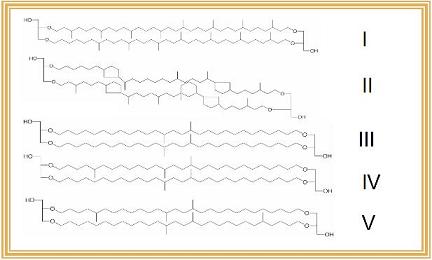
ACS PRF | ACS
All e-Annual Reports

43353-G2
Compound-Specific Radiocarbon Dating as a Tool for Understanding Timescales of Organic Matter Preservation in Coastal Marine Environments
Quantifying the sources and time scales of terrestrial organic carbon (OC) deposition in marine sediments is key to our understanding of organic carbon sequestration in the ocean and mechanisms of petroleum formation. In this ACS-PRF funded study we assess terrestrial carbon delivery to marine sediments using a newly introduced proxy for terrestrial OC, the Branched and Isoprenoid Tetraether (BIT) index (Hopmans et al., 2004) coupled to compound-specific radiocarbon analysis (Ingalls et al., 2006). The BIT index uses a ratio of four glycerol dialkyl glycerol tetraethers (GDGTs) from microbial membranes (Figure 1). One of these lipids, crenarchaeol (II) is derived from Crenarchaeaota and is ubiquitous in marine environments. The other three lipids (III, IV, V) are branched non-isoprenoidal GDGT lipids derived from peat- and soil-dwelling bacteria (Weijers et al., 2005). The BIT index is a ratio of the terrestrial lipids to the terrestrial and marine lipids (Figure 1).
In theory, the BIT Index is 0 in a sample where OC is marine-derived and 1 in a sample where OC is terrestrially-derived. We tested the BIT Index in soil, river bar deposits, fjords and margin sediments from the Pacific Northwest coast (USA and Canada; Figure 2). To assess the utility of the BIT index in this environment, BIT index values were compared to other more traditional proxies for terrestrial OC, including the C/N and d13C of bulk organic carbon and the concentrations of higher plant-derived lignin phenols. This is the first study to directly compare the BIT index to lignin phenol concentrations. In addition, we assessed the timescale of OC deposition by measuring the degradation state of the lignin phenols and the 14C ages of lipids I-V in each sample type using compound-specific radiocarbon analysis.
We found that it may be necessary to use multiple proxies of terrestrial organic matter in marine environments due to the diversity of OC sources on land. In particular, soil derived bacterial GDGTs and higher plant derived lignin phenols appear to be delivered to and buried in marine sediments in unequal quantities and on varying timescales. The soil bacterial GDGTs are relatively scarce in marine sediments relative to higher plant material. In addition, soil bacterial GDGTs are highly depleted in 14C suggesting either a long residence time in the soil or a relict carbon source (e.g. sedimentary rocks). In contrast, lignin phenol compositions suggest rapid delivery of fresh higher plant material to the coastal environment. Finally, significant quantities of crenarchaeol (II) are present in soils suggesting that it is not exclusively produced in the marine environment. Thus, examining only one group of biomarkers could be misleading. More work is needed to fully understand the relationships between the proxies, and how we can use them to quantify and identify sources of terrestrial organic matter in marine sediments.
The ACS-PRF funding provided a springboard for a beginning graduate student, Elly Walsh, who conducted this research. She will likely have at least two publications from this project. As a first year professor, this grant provided me the opportunity to begin a research project in a new direction prior to having the preliminary data that is often required for larger grant applications. It also allowed me to build a strong collaboration with Rick Keil, a colleague in my department. Some of our result will soon be published in Limnology and Oceanography, another manuscript is in preparation, and a proposal to continue this work in other locations will be submitted in the near future.

Figure 1: Marine archaeal and terrestrial bacterial GDGT lipids that are used as tracers of the importance of marine and terrestrial carbon sources. The BIT index is the ratio of III + IV + V / II + III + IV + V.

Figure 2: Map of study area showing where sediment core tops (yellow circles), soil (green stars) and radiocarbon analysis (pink arrows) samples were collected.